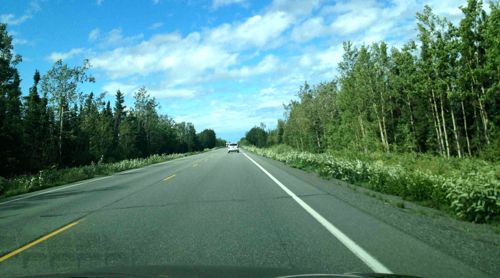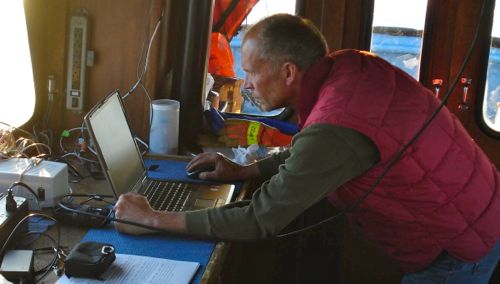Join the Polar research team as we use technology to join Dr. Carin Ashjian, Dr. Steve Okkonen, Dr. Bob Campbell and Phil Alatalo this summer as they continue their research in the Arctic! I will be posting Dr. Ashjians journal details of this summer's research expeditions onboard the R/V Anika Marie with Captain Bill Kopplin, where she and her team members will continue their Barrow-based research studying the oceanographic conditions of the bowhead whale habitat.
Year ten of our Barrow adventure!It is hard to believe that we have been coming here for 10 years. Had anyone told me that when we started, back in 2005, I would never have believed him or her! But here we are, slipping back into the routine like sliding a hand into an old, soft glove. One of the important things to do upon first arriving in Barrow is to touch base with our friends and colleagues and ask them the important questions: what is new in town, where are people working, are there any new restaurants, what is going on with the mayoral election, how are things in the ocean? Have you seen any whales yet?
We started our 10th anniversary trip by returning to Kasilof, AK, to visit our colleague Steve at his place on the bluffs overlooking Cook Inlet.
 Dr. Steve Okkonen serves up the "everything's better with bacon on it" dinner before heading to Barrow. Photo courtesy of Dr. Carin Ashjian. August 2014.
Dr. Steve Okkonen serves up the "everything's better with bacon on it" dinner before heading to Barrow. Photo courtesy of Dr. Carin Ashjian. August 2014.
 Halibut wrapped in bacon! Photo courtesy Dr. Carin Ashjian. August 2014.
Halibut wrapped in bacon! Photo courtesy Dr. Carin Ashjian. August 2014.
 The view from the car on the road from Anchorage to Kasilof. Here we had left the mountains around Turnagain Arm and were driving west towards Soldotna. Photo courtesy Dr. Carin Ashjian. August 2014.
The view from the car on the road from Anchorage to Kasilof. Here we had left the mountains around Turnagain Arm and were driving west towards Soldotna. Photo courtesy Dr. Carin Ashjian. August 2014.
Ten years ago we all did oil field worker safety training in order to enter the oil fields in Prudhoe Bay to access the boat. After the training, we had a few days to kill before heading north and so we went down to Kasilof. We thought it would be an appropriate recognition of our anniversary to return to Kasilof this year. Although the weather was on and off sunny, the scenery was fantastic.
 Steve’s dog Isis runs along with the truck down the beach. Isis is a husky who was an Iditarod dog (she ran the race 2x). She is incredibly fast and has amazing stamina. She very much enjoyed her run down the beach. Photo courtesy Dr. Carin Ashjian. August 2014.
Steve’s dog Isis runs along with the truck down the beach. Isis is a husky who was an Iditarod dog (she ran the race 2x). She is incredibly fast and has amazing stamina. She very much enjoyed her run down the beach. Photo courtesy Dr. Carin Ashjian. August 2014.
We arrived here in Barrow on Monday evening. Tuesday morning, we fell to moving gear to our lab, unpacking, and settling in. Two of us had gone to Deadhorse to join the R/V Annika Marie and ride her over from there to Barrow and two of us came directly from Anchorage to Barrow. Things have been going quite well this year. The boat was able to leave Prudhoe on Monday afternoon and made it to Barrow in a record (for us) 24 hours, including deploying a short-term mooring and picking up a wayward buoy for a colleague along the way.
 The R/V Annika Marie pulled up on the beach in Browerville (near NAPA). One of the town boat ramps is just beyond the boat. The boat ramp is a good way for the fuel truck to get close enough to the boat to fuel her. Photo courtesy Dr. Carin Ashjian. August 2014.
The R/V Annika Marie pulled up on the beach in Browerville (near NAPA). One of the town boat ramps is just beyond the boat. The boat ramp is a good way for the fuel truck to get close enough to the boat to fuel her. Photo courtesy Dr. Carin Ashjian. August 2014.
Wednesday we spent the day setting up on the boat – the most challenging activity was putting together the Tucker Trawl (really, we need instructions, it is like one of those mind bender puzzles). And then, yesterday we sampled for the first line, going across Barrow Canyon along Line 2.
 Glassy seas in Barrow Canyon on the afternoon of August 21. Photo courtesy Dr. Carin Ashjian. August 2014
Glassy seas in Barrow Canyon on the afternoon of August 21. Photo courtesy Dr. Carin Ashjian. August 2014
The weather was quite nice, very low winds with only small wavelets on the sea. The sky was light gray, with a light gray sea, during the morning but by mid-afternoon the clouds had lifted somewhat and patchy beams of sunlight were reaching the sea surface. Not a shred of sea ice was to be seen, no great surprise since the winds from the east had pushed all the sea ice to the north before our arrival. As the day progressed, the seas became calmer and at some locations glassy. Our sampling went well. To our surprise, the water temperatures in Barrow Canyon were the coldest that we have seen in our ten years of work here. There also was little water mass structure and the flow was to the NE all across the canyon. Our “cold” years of 2006 and 2008 had water temperatures that at least reached 4 deg. C., here we saw temperatures barely reaching 3 deg. C. Whales have already been seen between here and Prudhoe to the east. Yesterday, we saw no whales but we did see a few (5) seals.
 Steve downloads the data from his CTD. The CTD records the data internally. At the end of the day, he hooks the instrument up to a computer via a long cable and downloads the data. Here he is working on the lab counter in the cabin of the Annika Marie. Photo courtesy Dr. Carin Ashjian. August 2014
Steve downloads the data from his CTD. The CTD records the data internally. At the end of the day, he hooks the instrument up to a computer via a long cable and downloads the data. Here he is working on the lab counter in the cabin of the Annika Marie. Photo courtesy Dr. Carin Ashjian. August 2014
 ChukchiSunset: Sunset over the Chukchi Sea last night at about midnight. Photo courtesy Dr. Carin Ashjian. August 2014
ChukchiSunset: Sunset over the Chukchi Sea last night at about midnight. Photo courtesy Dr. Carin Ashjian. August 2014
One of the other big surprises for us is that this year we are besieged by large, slow flying, heavy mosquitoes. The mosquitoes of Alaska are notorious in their density, ferocity, and size but we have never been in Barrow while there were mosquitoes. The air temperature here has been quite warm (in the 50s today) recently, although it was a colder than normal summer. Perhaps the mosquitoes have only now been able to hatch and survive in these warmer temperatures. Whatever the reason, it is a rude shock to be besieged by thick clouds of large, soggy when smacked, flying insects. The one consolation is that they are relatively easy to catch.
Curious to see some Arctic mosquitoes in action?
If you'd like to get a better idea of what the mosquitoes are really like in the Arctic, check out the two video links below. The first link is a clip from the movie Fantastic Animals and is an eye-opening look at how these tiny voracious blood sucking predators are not only an annoyance for humans.
http://
This second video link takes you to the Toolik Field Station in Alaska where researchers stationed there decided to have a little fun with their mosquito population. http://

